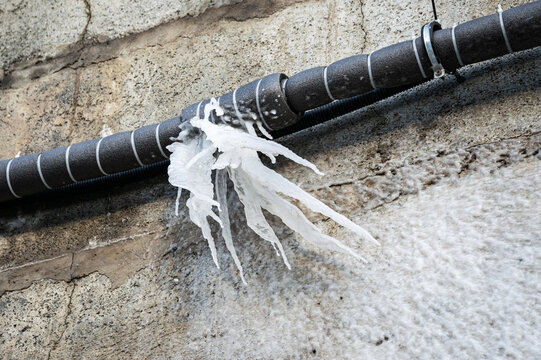How to Protect Your Pipes from Cold Weather Damage: Important Advice
How to Protect Your Pipes from Cold Weather Damage: Important Advice
Blog Article
What are your thoughts on 6 Ways to Prevent Frozen Pipes?

Cold weather can damage your pipes, specifically by freezing pipelines. Right here's exactly how to stop it from taking place and what to do if it does.
Intro
As temperature levels decline, the threat of frozen pipelines boosts, possibly bring about pricey fixings and water damages. Understanding how to avoid frozen pipes is essential for property owners in chilly climates.
Avoidance Tips
Shielding vulnerable pipes
Wrap pipes in insulation sleeves or use warmth tape to protect them from freezing temperatures. Focus on pipes in unheated or exterior locations of the home.
Home heating methods
Keep indoor areas appropriately warmed, particularly areas with plumbing. Open up cupboard doors to permit warm air to circulate around pipelines under sinks.
Exactly how to identify icy pipes
Try to find decreased water circulation from taps, unusual smells or sounds from pipes, and visible frost on revealed pipes.
Long-Term Solutions
Structural changes
Consider rerouting pipes far from outside walls or unheated areas. Include added insulation to attics, basements, and crawl spaces.
Upgrading insulation
Buy high-quality insulation for pipes, attic rooms, and wall surfaces. Correct insulation helps maintain constant temperatures and decreases the risk of icy pipelines.
Securing Outdoor Plumbing
Yard hoses and outside faucets
Detach and drain yard pipes before winter season. Install frost-proof faucets or cover exterior taps with protected caps.
Comprehending Frozen Pipes
What creates pipelines to freeze?
Pipes ice up when subjected to temperatures listed below 32 ° F (0 ° C) for prolonged periods. As water inside the pipelines ices up, it expands, taxing the pipe wall surfaces and potentially causing them to break.
Risks and problems
Frozen pipelines can lead to water interruptions, residential or commercial property damages, and expensive fixings. Burst pipelines can flooding homes and cause comprehensive architectural damages.
Indicators of Frozen Water Lines
Determining icy pipelines early can avoid them from bursting.
What to Do If Your Pipelines Freeze
Immediate activities to take
If you presume frozen pipes, maintain taps available to ease pressure as the ice melts. Make use of a hairdryer or towels soaked in hot water to thaw pipes slowly.
Final thought
Stopping icy pipes calls for positive procedures and fast reactions. By comprehending the reasons, indications, and preventive measures, property owners can protect their plumbing during winter.
6 Proven Ways to Prevent Frozen Pipes and Protect Your Home
Disconnect and Drain Garden Hoses
Before winter arrives, start by disconnecting your garden hoses and draining any remaining water. Close the shut-off valves that supply outdoor hose bibs and leave the outdoor faucet open to allow any residual water to drain. For extra protection, consider using faucet covers throughout the colder months. It’s also important to drain water from any sprinkler supply lines following the manufacturer’s directions.
Insulate Exposed Pipes
Insulating your pipes is an effective way to prevent freezing. Pipe insulation is readily available at home improvement stores and is relatively inexpensive. Pay close attention to pipes in unheated areas such as the attic, basement, crawl spaces, or garage. Apply foam insulation generously to create a buffer against the cold. You can also wrap your pipes in heat tape or thermostat-controlled heat cables for added warmth.
Seal Air Leaks
Inspect your home for any cracks or openings that could let in cold air. Seal any holes around the piping in interior or exterior walls, as well as the sill plates where your home rests on its foundation. Additionally, make sure to keep your garage door closed unless you’re entering or exiting. Leaving it open creates a significant air leak that can lead to frozen pipes.
Allow Warm Air Circulation
During cold snaps, it’s essential to allow warm air to circulate evenly throughout your home. Leave interior doors ajar to promote better airflow. Open kitchen and bathroom cabinets to help distribute heat consistently around the rooms. If you have small children or pets, be sure to remove any household chemicals or potentially harmful cleaners from open cabinets for safety.
Let Faucets Drip
A small trickle of water can make a big difference in preventing ice formation inside your pipes. When temperatures drop significantly, start a drip of water from all faucets served by exposed pipes. This continuous flow helps prevent the water from freezing. Additionally, running a few faucets slightly can relieve pressure inside the pipes, reducing the chances of a rupture if the water inside does freeze.
https://choateshvac.com/6-proven-ways-to-prevent-frozen-pipes-and-protect-your-home/

Hopefully you enjoyed reading our topic about 6 Ways to Prevent Frozen Pipes. Thank you for taking time to read through our blog. If you please take a moment to share this entry if you enjoyed reading it. I love your readership.
Call Today Report this page